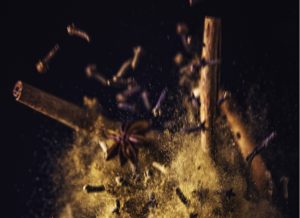
I don’t know anyone that doesn’t like cinnamon, do you? It is a favorite in many American recipes, especially in baking. Used both in the ground and the stick form in Indian cooking, cinnamon is used in curries, rice dishes and to flavor meats as well as teas. Cinnamon is the dried inner bark of the laurel tree. Cinnamon is found in the Himalayas, Ceylon, and Malaysia.
Cinnamon has a great historical story. The first definite mention of a particular spice is of cinnamon in the Bible and the Egyptian Papyri. It is said that God commanded Moses to include cinnamon in a recipe for sacred anointing oil. The Son of Solomon praises its scent and the Greeks and Romans offered it to their gods. In India and China, it was used as medicine.
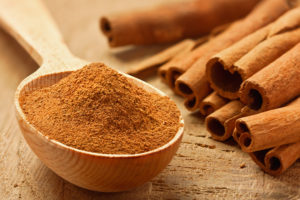
The Indians have always used cinnamon, but the Greeks and Romans did not really use it in their cooking until around the third and fourth centuries. They used it first as a medicine, a cordial and as an aphrodisiac. In China, cinnamon or cassia had the highest possible reputation: it was supposed to confer immortality-or almost. To the Taoists it was the food of the immortals, a kind of ambrosia. Carried on the person in a kind of pomander, a piece of cinnamon was used to avert disease, and help the sensitive nostrils of the prosperous people who wore it to endure the stench of the towns of the time.
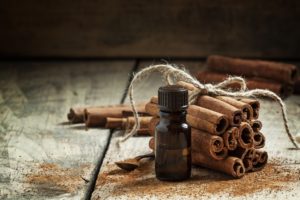
In Ayurveda, it is used for respiratory ailments, stomach aches, muscles spasms and of course for diabetes. In Chinese medicine it is used now and continues to be use for its “warming qualities”, particularly for respiratory problems and muscle aches. It is also the major ingredient in Tiger Balm, the popular Chinese ointment for pain relief.
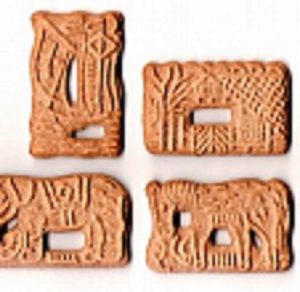
More than a medicine, it is a common and loved ingredient in cuisines around the world. We use it in the US and Europe in sweet dishes as apple pie, coffee cake, fruit compotes, buns, muffins, doughnuts, cakes and cookies. It is also in mulling spices and openly sprinkled on whipped cream. Cinnamon sticks are stirred into hot beverages, including ciders and wines. In England they call is cassia. Many keep it in a large container on the table for easy access when wanting to sprinkle it on sweets and beverages. In Spain, cinnamon is popular in chocolate dishes and confections. In Germany it is in apple strudel and foods containing raisins. In Netherlands, cinnamon is a dominate flavor in the Christmas spiced cookie called speculaas. A picture of these cookies is above.
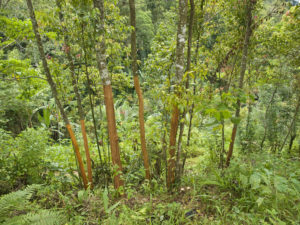
Knowing Your Cinnamon-
Cassia cinnamon (Cinnamomum cassia) and true cinnamon (Cinnamomum verum) belong to the same botanical family (Cinnamomum). They also look alike even though cassia is the sweeter and stronger of the two and the one preferred throughout the world as culinary spice. True cinnamon is found in kitchens in Mexico, Latin America, India and other nations on South Asia.
In the United States, both are sold as cinnamon, however in other countries such as Great Britain and Australia, Cinnamomum Cassia can only be sold as cassia and Cinnamomum Verum can only be sold as cinnamon. You can find true cinnamon in Indian markets and specialty spice shops such as Penzy’s Spices in Dallas at 635 and Preston Road.
Benefits-
Its benefits are surprising. This spicy-sweet flavor can help control blood sugar problems. The rate of Type 2 diabetes in the United States has doubled in the past two decades. In fact 10% of all American adults are now under its influence according to the CDC. Managing this disease requires losing weight, eating more whole foods, exercising regularly and taking glucose-controlling meditations such as insulin.
But what if we grabbed onto the crazy idea of never getting diabetes in the first place…such a novel idea, right! So think about adding cinnamon to your diet if you haven’t already.
Cinnamon may also help prevent and /or treat:
• Antimicrobial
• Cancer
• Cholesterol problems
• Food poisoning
• Heart disease
• High blood pressure
• Improves circulation
• Insulin resistance (prediabetes)
• Metabolic syndrome
• Polycystic ovarian syndrome
• Stroke
• Triglyceride (high)
• Ulcers
• Vaginal yeast infection
• Wounds
Ayurveda
There are 3 main types of dried cinnamon bark used in Ayurvedic medicines and recipes:
1. The bark of the Chinese cinnamon tree, which is thick, very rich in oil, and khaki in color
2. The bark of the Taj tree, which is grown in western and southern India and produces no oil.
3. The bard of the Ceylon cinnamon bush, obtained from its tender branches, is thin and reddish brown, in color, aromatic, and rich in oil.
The cinnamon in the picture below is from Tanzania.
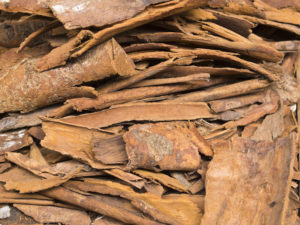
How to purchase
Both cassia and true cinnamon are harvested from dried bark and rolled, scroll-like, into tight quills—or what we call cinnamon sticks. These quills are usually cut into four or five inch pieces.
True cinnamon grows wild in South India, the best is from Sri Lanka, off the coast of South India. Cassia is grown in China, Vietnam and Indonesia.
The best cinnamon is harvested from the trunk and is graded according to its length, breath and thickness. Once ground, cinnamon begins to lose the fragrance that comes from its volatile oils, so it’s best to buy whole quills and grind them as needed. If your only option is to buy ground cinnamon, you’ll get the most fragrance from the finest quality which is smooth rather than gritty. Whole quills keep for three years as long as they aren’t in extreme heat. Ground cinnamon begins to fade in flavor after a few months.
Some easy ways to use
• Add cinnamon to enhance chai, hot chocolate or warm milk
• Mix cinnamon into rice pilaf
• Combine equal parts of cinnamon, cardamom and black pepper and rub into pork tenderloin or lamb before baking
• Mix cinnamon with mint and parsley in ground beef or burgers or meatloaf
• Sprinkle cinnamon on apples, bananas, melons and organs
• Sprinkle some cinnamon into pastry dough for pies and quiches
• Put a cinnamon quill in beef or vegetarian stews or in lentil soup.
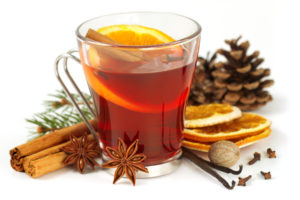
Spiced Wine
Put a bottle of wine in a large pot and gently simmer it with ½ cup of sugar, a cinnamon stick, and a lemon studded with cloves for 15 minutes.
Spiced tea
Put a quart of brewed tea in a pot, add two cups of apple juice, and gently simmer it with a sliced lemon and two cinnamon sticks for 10 minutes.
With the Holidays coming up I am sure that cinnamon will be part in your celebrations. Please share this blog with your friends.and as always, thanks for following thebalancedyogi.com
Health and Happiness,
Peggy
